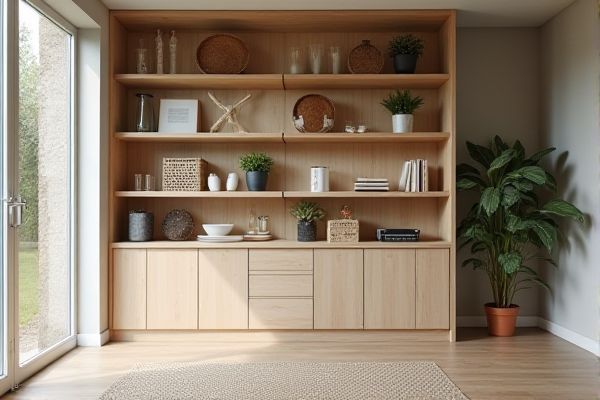
Cabinet storage offers concealed organization that keeps items protected from dust and creates a streamlined look, while open shelving provides easy access and displays your belongings as part of the room's decor. Discover which storage solution best suits your space and lifestyle by reading the rest of the article.
Table of Comparison
| Feature | Cabinet Storage | Open Shelving |
|---|---|---|
| Visibility | Hidden, clutter-free appearance | Full display, easy access |
| Dust Protection | High protection against dust | Minimal dust protection, frequent cleaning needed |
| Organization | Better for concealed, varied storage | Best for decorative and frequently used items |
| Installation | Complex, requires hardware | Simple, often DIY-friendly |
| Cost | Typically higher due to materials and labor | Generally lower, less material needed |
| Design Style | Traditional to modern, formal look | Modern, casual, and airy aesthetic |
| Space Utilization | Maximizes hidden storage space | Less storage capacity, more open space |
Understanding Cabinet Storage and Open Shelving
Cabinet storage offers concealed space to keep your items organized and protected from dust, making it ideal for a clutter-free look. Open shelving provides easy access and displays decorative items, enhancing the room's aesthetic while encouraging tidiness. Understanding the balance between cabinet storage and open shelving helps you optimize functionality and style in your home.
Design Aesthetics: Traditional vs. Modern Appeal
Cabinet storage offers a traditional design aesthetic with clean lines and concealed organization, creating a polished and timeless look ideal for classic interiors. Open shelving delivers a modern appeal by showcasing everyday items and decorative pieces, contributing to an airy and visually dynamic space. Homeowners seeking a minimalist yet functional design often prefer open shelving, while those valuing order and elegance tend to choose cabinet storage.
Space Efficiency and Organization
Cabinet storage offers superior space efficiency and organization by maximizing vertical and enclosed spaces, keeping items out of sight and protected from dust. Open shelving provides quick access and visibility but often requires more meticulous arrangement to prevent clutter. Your choice impacts how effectively you use available space and maintain order in your kitchen or living area.
Accessibility and Everyday Convenience
Cabinet storage offers concealed compartments that keep items organized and protected from dust, enhancing the overall tidiness of a space. Open shelving provides immediate access to frequently used items, promoting ease of retrieval and encouraging consistent use. For everyday convenience, the choice depends on balancing the need for quick access with preferences for maintaining a clutter-free environment.
Visual Clutter vs. Clean Lines
Cabinet storage effectively reduces visual clutter by concealing items behind doors, creating clean lines that promote a sleek and organized appearance. Open shelving exposes contents, which can lead to a more dynamic but potentially cluttered look if not meticulously arranged. Choosing between the two depends on the desired balance between minimalism and display aesthetics in interior design.
Maintenance and Cleaning Requirements
Cabinet storage offers the advantage of protecting your items from dust and dirt, significantly reducing cleaning frequency compared to open shelving. Open shelving requires regular dusting and wiping since items are exposed, making maintenance more time-consuming. Choosing cabinet storage can simplify upkeep, especially in kitchens or bathrooms where hygiene is a top priority.
Customization and Flexibility
Cabinet storage offers extensive customization options, allowing you to tailor the interior layout with adjustable shelves, pull-out drawers, and built-in organizers to maximize space efficiency. Open shelving provides flexibility by enabling easy access and quick reconfiguration of display items, ideal for frequently used kitchen essentials or decorative pieces. Your choice depends on whether you prioritize personalized compartmentalization or adaptable, visually accessible storage solutions.
Cost Comparison: Budgeting for Your Space
Cabinet storage typically involves higher upfront costs due to materials, hardware, and installation fees, making it a more significant investment for your space. Open shelving is generally more budget-friendly, requiring fewer materials and simpler installation processes, which helps reduce expenses. Evaluating the long-term durability and maintenance needs of each option can further guide your cost-effective decision.
Best Uses: Kitchen, Bathroom, and Beyond
Cabinet storage excels in kitchens and bathrooms by providing concealed space that keeps items organized and protected from moisture and dust, ideal for cookware, toiletries, and cleaning supplies. Open shelving suits frequently used kitchen items like spices and everyday dishes, also enhancing bathroom displays of towels and decorative elements while encouraging tidiness. Beyond these rooms, cabinet storage offers a polished look for offices or living areas, whereas open shelving supports easy access and aesthetic display in creative studios or retail environments.
Making the Right Choice for Your Home
Cabinet storage offers concealed organization and protection from dust, making it ideal for maintaining a tidy, clutter-free space, especially in kitchens and bathrooms. Open shelving provides easy access and showcases decor or frequently used items, enhancing visual appeal and encouraging minimalism. Consider your lifestyle, storage needs, and aesthetic preferences to determine whether the practical durability of cabinets or the airy openness of shelves best complements your home's functionality and design.
 homyna.com
homyna.com